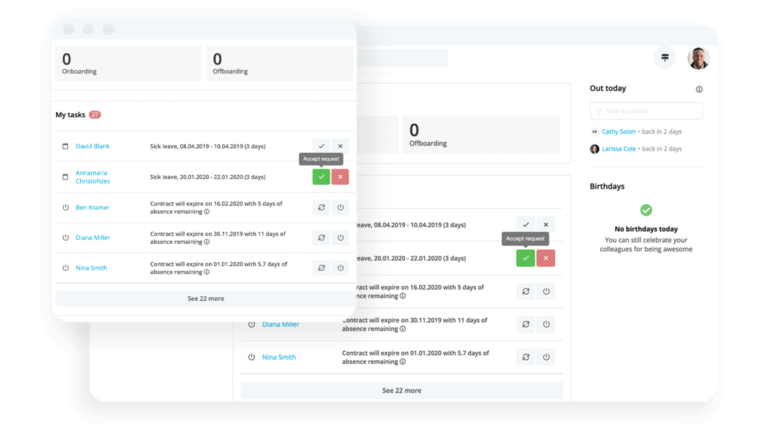
People Strategy Guidebook
A free guide to help power your next great people strategy.
Download our guide to developing your organization’s own people strategy today.What is Staff Management, Really?
Employing staff management strategies in your organisation can have a significant impact on, well, everything. From employee experience to performance optimisation to achieving objectives and way more.
In this quick guide, we’ll walk you through the basics of staff management, what the process looks like and some strategies you can use to boost productivity.
Definition of Staff Management
Staff management (also called employee management) is an important part of HR management that involves supervising, guiding, and improving employees’ performance over time. Staff management involves areas such as recruitment, development, measurement and rewarding/discipline.
Staff Management Process
The staff management process is a series of activities and steps used to manage employees in a business. The specific process used will differ slightly depending on the organisation, but it generally follows these five steps: resource allocation, recruiting talent, selection and hiring, staff training and development and reviewing staff performance and giving credit.
1) Resource Allocation
The first step in staff management is to plan out resource allocation. How many staff are needed? In which departments? How much budget is allocated?
Understanding the employee needs for the organisation and divvying up the available resources will set a foundation for the rest of the process.
2) Recruiting Talent
The recruitment step of the staff management process includes identifying what type of staff the business needs (i.e. the required roles and responsibilities that need to be covered) and creating job postings to attract the right talent. This includes planning recruitment strategies, advertising job openings and screening applicants.
3) Selection and Hiring
Once potential employees are identified and interviewed, the organisation must decide which one is the best fit for the position. This step has high stakes, as selecting the wrong candidate loses time and money for the organisation and can increase turnover.
15,000 organisations trust Personio for this reason

Just like LUSH and Premier Inn, trust Personio's all-in-one HRIS to upgrade your people operations for now and into the future. Click below to learn more about us.
Book Your Demo4) Staff Training and Development
Once the right candidates have been identified, the business can start the onboarding process and move onto training and development. The purpose of this step is to help employees better understand their roles and responsibilities, as well as to help them learn new skills and continually improve performance.
5) Reviewing Staff Performance and Giving Credit
The last step in the staff management process is appraising employees’ performance. It’s important to determine whether each member of staff is meeting performance expectations, achieving specific metrics or goals and growing over time. Then, their role, compensation, and responsibilities can be updated as needed (e.g. promotions).
9 Strategies to Effectively Manage Your Staff
There are a variety of strategies and best practices to enable effective staff management. Here are a few to get you started:
1. Be a Leader Before Being a Manager
Leadership is the ability to influence people and drive them to achieve a common goal. A leader typically has the vision, inspiration and charisma to lead a team and can provide direction and motivation. Leaders have the capacity to identify a need, visualise a solution and enlist the help of those around them to reach the goal.
A manager, on the other hand, is usually focused on the details of running a team or organisation – ensuring that tasks are completed on time, overseeing the day-to-day operations, etc.
Focusing on being a leader over being a manager will lead to more effective and motivating staff management.
2. Set Up a Reward Program
Rewards and recognition are crucial to improve the employee experience, motivate staff members, shape culture, and boost retention. When employees feel appreciated – either through formal recognition or some type of material reward – they will feel encouraged to continue their good performance.
A reward program could include naming an employee of the month, special staff excursions, or other unique benefits. Just remember to be fair with your rewards – don’t play favourites.
3. Communicate With Your Staff
Communication is an essential piece of staff management, both on the leadership side (e.g. convey clear and concise instructions) and on the employee side (e.g. communicating successes and failures).
Open lines of communication should also be encouraged, and managers should ensure that their staff feels comfortable to come to them with any ideas, concerns or questions. This will create an environment in which employees feel valued, respected and motivated.
4. Actively Listen
One of the most important parts of effective communication is active listening: being actively engaged with what another person is saying to us, rather than passively hearing it or thinking about other things.
Without active listening, leaders can’t truly understand what their staff needs or the information they are trying to convey. The practice of active listening gives every employee the chance to share opinions, feel empowered and bring about positive change in the organisation.
Find Out What Your Employees Really Need

Try this helpful template to run your next company-wide survey. Take the pulse of your organisation today.
Get The Free Template5. Get to Know Your Staff
To ensure effective staff management and also build a positive work culture, leaders need to get to know your staff. This doesn’t mean they need to be best friends – the relationships should remain professional – but knowing employees on a personal level will make the day-to-day experience more enjoyable and engaging for them.
A few ideas to get to know your staff better:
Ice breakers before team meetings
Starting each 1-on-1 with a few minutes of personal chatting
Monthly or bimonthly coffees (virtual or in-person) to talk about anything besides work
6. Encourage Learning
A culture of learning and development benefits all sides of the organisation. From a staff management perspective, it helps to upskill your workforce and continually improve the skills and experience available to the organisation. It also boosts retention – a key to solid and consistent staff management.
From an employee perspective, a culture of learning allows them to gain experience, enhance their skills and abilities, boost confidence and experiment with new ways of doing their job.
7. Provide Constructive Criticism
Constructive criticism or feedback plays a key role in staff management. No workforce (or employee) is perfect, and as a manager, you want to help your employees grow – both for their sake and for the success of the organisation.
Offering constructive feedback helps employees to improve on their areas of opportunity. To be constructive, feedback should be presented in a positive way that is easy to understand, and should be followed up with 1) ideas for how to improve, and/or 2) a conversation about a plan for moving forward.
8. Build Trust
Building a relationship of trust with employees will help them feel supported and motivated, while also creating a better environment for collaboration. Many of the other strategies listed here will also help to build trust, for example active listening, open communication and constructive feedback.
9. Healthy Delegation
Delegating work is a crucial part of any effective staff management strategy. After all, managers need to run the day-to-day operations and ensure roles, responsibilities and expectations are communicated to all team members.
However, delegating is not the same as dictating – don’t just dump work on employees and demand that they do it in a certain way. Instead, guide them with clear instructions, support them to be innovative and productive and collaborate with them to create a true team environment.
Frequently Asked Questions (FAQ) About Staff Management
What Is Staff Management?
Staff management refers to the process of supervising and guiding employees to optimise their job performance. Included in staff management are areas such as recruiting, learning and development, measuring against metrics and recognition.
What Is the Staff Management Process?
The staff management process is made up of a series of steps used to manage employees and their performance in an organisation. The process generally follows these five steps:
Resource allocation
Recruiting talent
Selection and hiring
Staff training and development
Reviewing staff performance and giving credit
How Can Employers Manage Underperforming Staff?
An important part of staff management is knowing how to handle employees who are underperforming. There are a variety of ways for employers to manage this, but the most important thing is communication and offering constructive feedback. You want to offer employees the chance to improve performance before considering other options.
Simplified Staff Management with Personio
The process of staff management is made easier with Personio. From recruiting and managing on- and offboarding to L&D and tracking performance, our platform has you covered. Book your demo today

